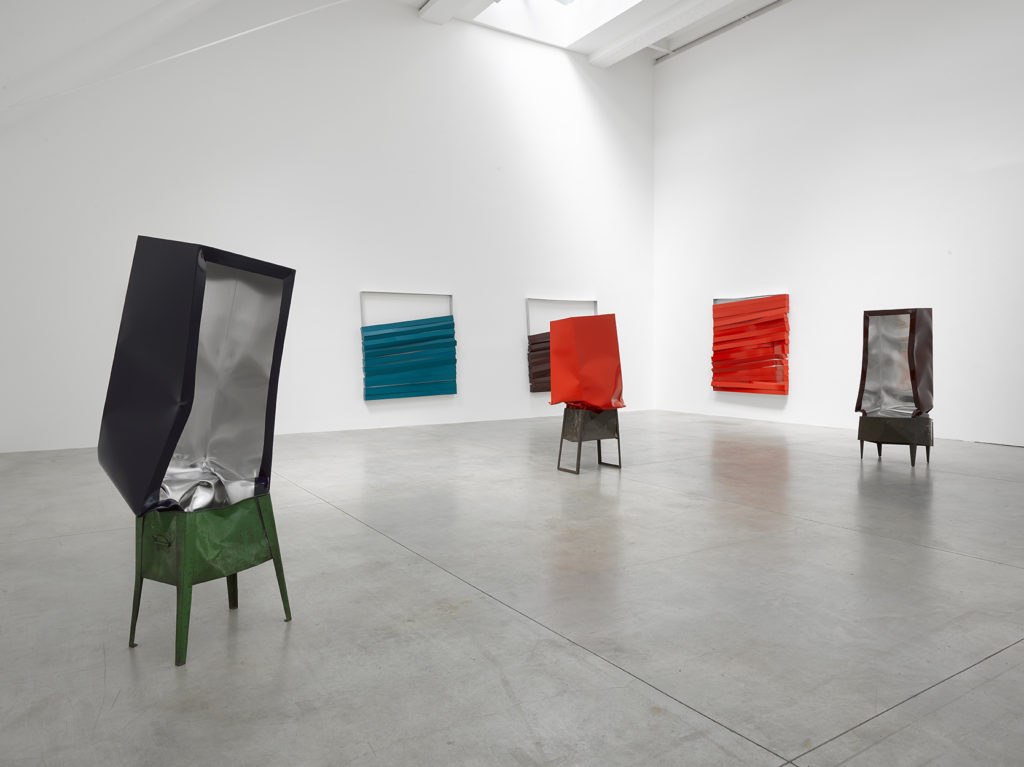On View
How Sculptor Angela de la Cruz Uses Twisted Metal to Explore the Vulnerability of the Body at Lisson Gallery
In a new video, the gallery offers insight into “Bare,” de la Cruz’s new show on view now in London.
In a new video, the gallery offers insight into “Bare,” de la Cruz’s new show on view now in London.
Taylor Dafoe

“I have been thinking about this concept of ‘Bare’ for some time—considering what is open to view, what is exposed, what the future holds,” the Spanish-born artist remarks in a statement for the show. “I feel like we are walking into an unknown. The works in this show are all united through their bareness: be it perceptible openness or exposure—they all appear precarious, vulnerable and unprotected.”
At first glance, the artist’s exploration of those themes may seem counterintuitive. The works in the show, like much of de la Cruz’s previous output, can look like the product of carnage. The pristinely painted material—aluminum, in most cases—of her sculptures and paintings is torn, crushed, or folded, often all at once.
That visual tension, of course, is the point. The works in “Bare” are supposed to feel a little disquieting, both in their relationship to the artist and in the social context of the day.
“Angela’s been exploring the political uncertainty that’s surrounding society at the moment,” says Emma Gifford-Mead, Lisson’s head of exhibitions, in a video produced by the gallery. “This instability—not quite knowing where things are or how things are going to unfold. Angela wanted to create this tension in the work.”

Installation view of Angela de la Cruz’s exhibition “Bare” at Lisson Gallery, 2018. Courtesy of Lisson Gallery.
The wall-hung works in the show are composed of overlapping aluminum slats mounted on exposed rectangular structures—harkening back to a previous body of work by the artist in which she removed and reattached painting canvases to reveal the stretcher underneath. Meanwhile, the standalone sculptures feature large aluminum structures forcibly inserted into metal filing cabinets.
“There’s a dialogue between the painted surface and the exposition of the materials behind the surface,” Gifford-Mead says. “They’re really painted very beautifully on the outside, but if you look behind, you can see that they’re also exposed.”

Angela de la Cruz in a still from the video. Courtesy of Lisson Gallery.
In both their scale and physicality, the works invoke a relationship to the human body—and to the artist herself. De la Cruz has been largely confined to a wheelchair for the last 13 years, after suffering a brain hemorrhage in 2005.
“The work, be it in metal or concrete or canvas, will always have an anthropomorphic aspect to it,” Luke Barton, one of de la Cruz’s studio assistants, says in the video. “She sees every work as having a relationship to her own body.”
“Angela de la Cruz: Bare” is on view through August 18, 2018, at Lisson Gallery in London.